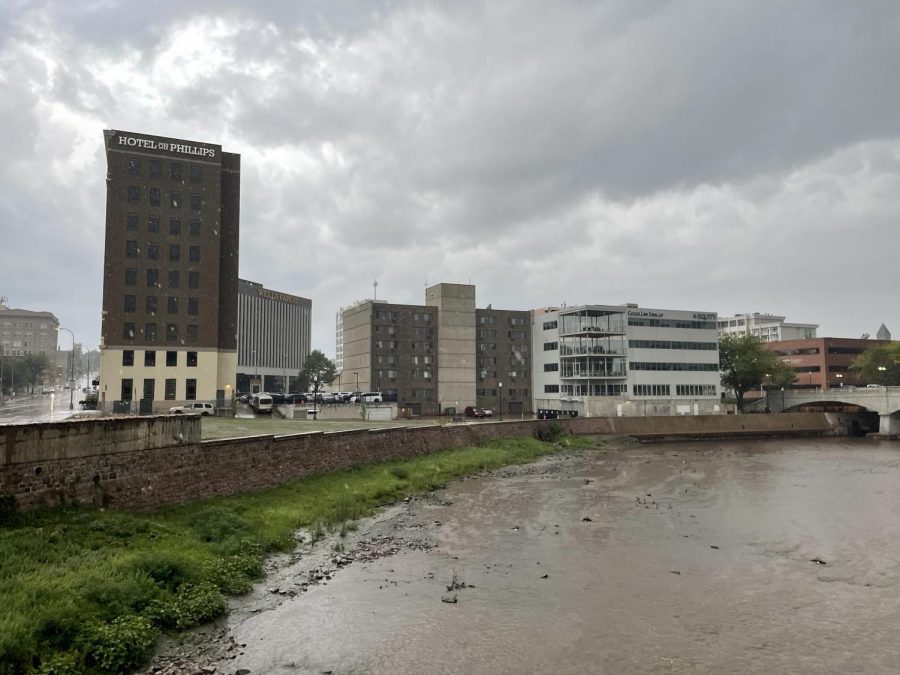Sioux Falls’ problematic layout
Sioux Falls’ layout increasingly perpetuates and exacerbates socioeconomic inequalities; what can be done?
November 15, 2021
Sioux Falls has doubled in size since 1980. As one of the fastest growing cities in the country, it is undergoing a massive expansion and transformation. Unfortunately, as the city continues to expand, the layout of Sioux Falls increasingly perpetuates and exacerbates socioeconomic inequalities.
A key component of whether a city’s layout is problematic is cohesion. Central Sioux Falls, built up before the proliferation of cars, is relatively cohesive. Its neighborhoods are dense and walkable, generally adhering to a grid pattern. Each block has character, and each building is unique as opposed to the architectural homogeneity all too common in far outskirts of the city. In car-scaled suburbia, with streets that unnecessarily twist and curve, one cannot walk to the grocery store, nor much else. The only thoroughfares that don’t loop into each other out there are highways.
While such highways sometimes offer a meager, treeless sidewalk parallel to the six lanes of screeching engines we call a street, these sidewalks are always superficial and underutilized; walking along them is nearly impossible. Suburbia, rapidly and disproportionately expanding in our city, is no friend to the pedestrian. Indeed, it ostracizes would-be pedestrians, forcing people to have cars. Those who can’t afford one are left with few options.
Take the Dawley Farm Village in eastern Sioux Falls. There are three ways to walk there: cross Highline Place (5 lanes), cross Arrowhead Parkway (6 packed lanes) or walk through a parking lot bigger than the Titanic. In any case, the pedestrian bends to the will of the car, around which Sioux Falls is built. Car culture extends beyond streets, though. Since cars are the priority, parking lots become larger and larger until eventually they obscure their store(s) so much it appears that the parking lots themselves are the main attraction, and the stores are but islands in them.
Sometimes the lack of a major street is also a problem. Notably, 26th Street does not cross over the Big Sioux River into western Sioux Falls. For most, this means the only way to the west side is via the interstate (increasing reliance on cars), 12th Street or 41st. If the Country Club was not in the way, a bridge could be constructed, alleviating some traffic and making the west side more accessible. Unfortunately, instead of aiding (pedestrian) accessibility for the many, Sioux Falls prefers aiding golf games for the few.
Flawed urban design isn’t merely an optics or accessibility problem; it’s life or death. Urban sprawl, one of the greatest threats to our city, is increasing pollution and decreasing walkability. This exacerbates climate change and personal health problems. In fact, according to the National Library of Medicine, 20% of all deaths could be prevented by building cities more efficiently.
It may seem dire but flawed urban design can be mitigated. One might initially think that more lanes would alleviate traffic and aid pedestrians, but this only worsens urban sprawl. Furthermore, as the American Economic Review noted, more lanes empirically leads to more traffic, as the extra space pulls more cars to the road in a phenomenon known as induced travel demand. This leads to more traffic fatalities (which is why denser cities like Stockholm and Tokyo report the lowest traffic fatality rates in the world) and a weaker sense of neighborhood unity.
We must not let sprawling concrete oceans and highway entanglements impede walkability, neighborhood cohesion or access to resources. Thus, no one in a city should live more than a 15 minute walk from the essentials (e.g., grocery stores). As The Congress for New Urbanism stated, such a “15-minute city” would be more socioeconomically equitable and bolster health. The model would also be a boon to struggling communities and small businesses.
To achieve this goal, cities must prioritize mixed-use and dense zoning. On this front Sioux Falls has much work to do, much of which may seem impractical. But it is feasible. Other cities across the nation are retrofitting suburbia and low density areas. They are setting buildings closer to the sidewalk to increase cohesion and the sense of “place.” They are expanding public transit, planting trees along wide sidewalks and prioritizing development in the urban core. They are becoming stronger, more vibrant cities.
Sioux Falls can too. Under clear and firm guidance, with a decent respect to the needs of pedestrians, we can and will become a city that maximizes wellbeing and resource access for all.









